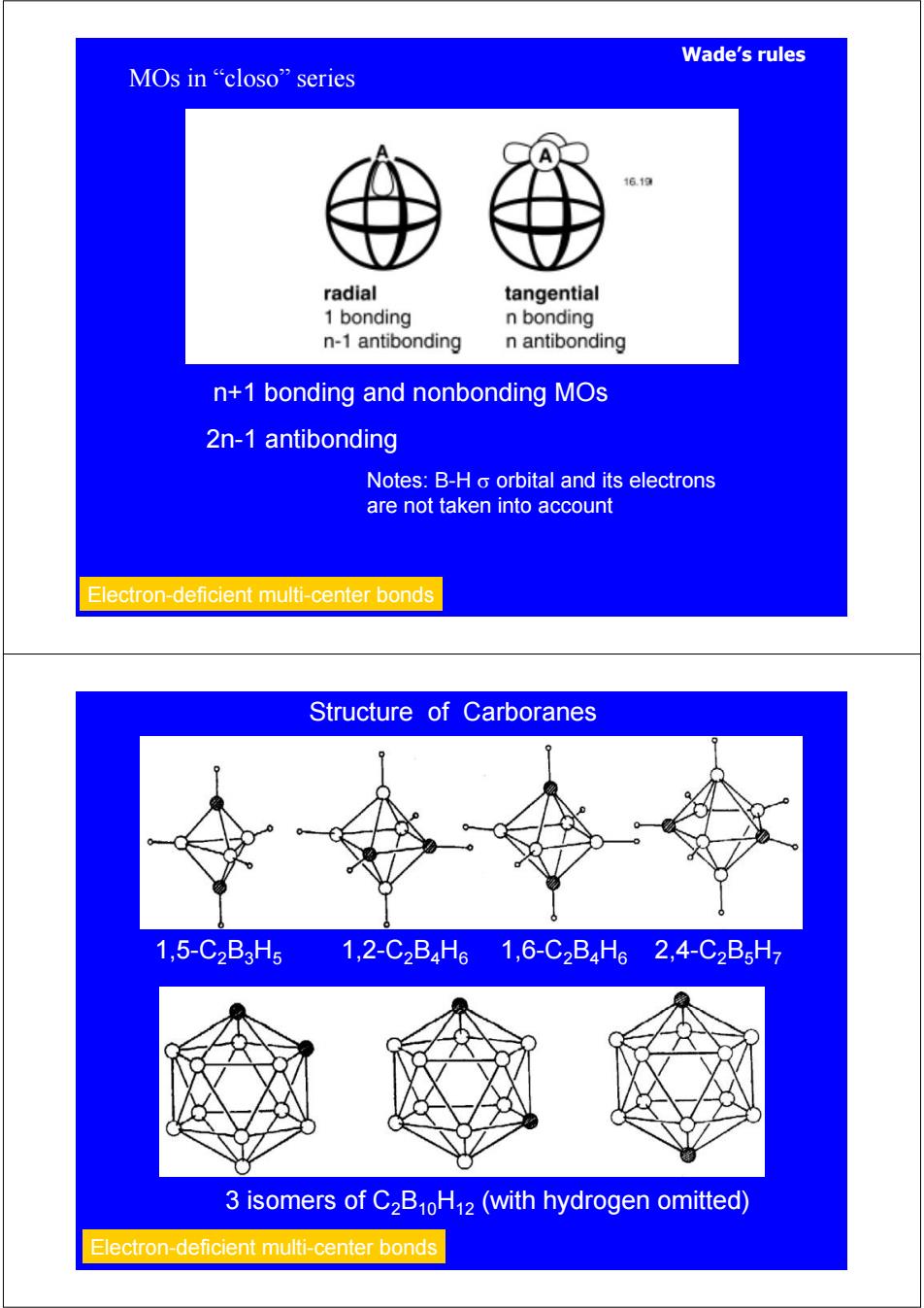
Wade's rules MOs in "closo”series 16.1a radial tangential 1 bonding n bonding n-1 antibonding n antibonding n+1 bonding and nonbonding MOs 2n-1 antibonding Notes:B-H o orbital and its electrons are not taken into account Electron-deficient multi-center bonds Structure of Carboranes 1,5-C2B3H5 1,2-C2B4H61,6-C2B4H62,4-C2B5H7 3 isomers of C2B10H12 (with hydrogen omitted) Electron-deficient multi-center bonds
Wade’s rules n+1 bonding and nonbonding MOs 2n-1 antibonding Notes: B-H σ orbital and its electrons are not taken into account Electron-deficient multi-center bonds MOs in “closo” series Structure of Carboranes 1,5-C2B3H5 1,2-C2B4H6 1,6-C2B4H6 2,4-C2B5H7 3 isomers of C2B10H12 (with hydrogen omitted) Electron-deficient multi-center bonds
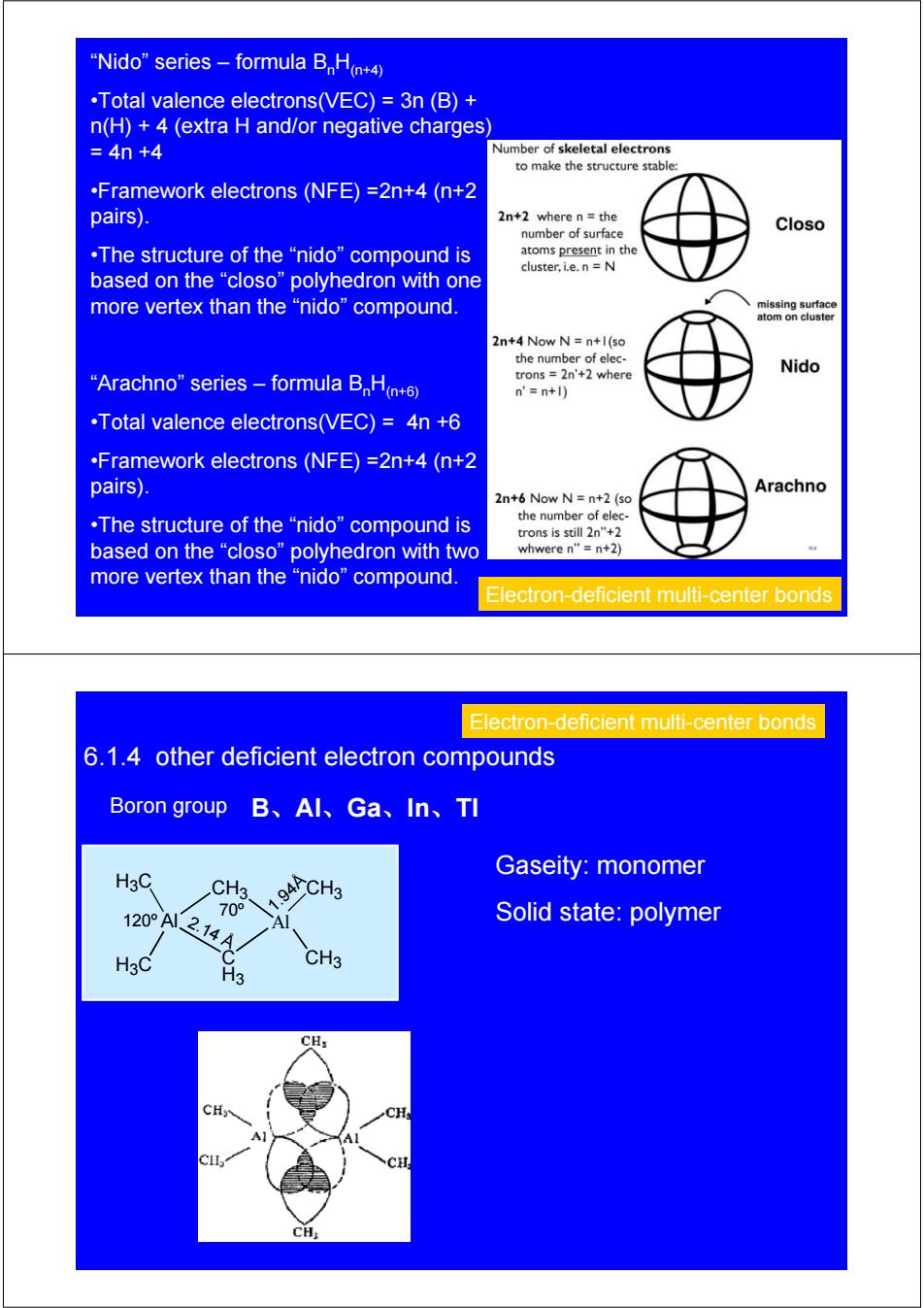
"Nido"series -formula BH+4) .Total valence electrons(VEC)=3n (B)+ n(H)+4 (extra H and/or negative charges) =4n+4 Number of skeletal electrons to make the structure stable: .Framework electrons (NFE)=2n+4(n+2 pairs). 2n+2 where n=the number of surface Closo ,The structure of the“nido”compound is atoms present in the cluster,i.e.n =N based on the“closo”polyhedron with one more vertex than the“nido”compound, missing surface atom on cluster 2n+4 Now N=n+l(so the number of elec- trons 2n'+2 where Nido “Arachno”series-formula B,Ha+6 n'=n+) .Total valence electrons(VEC)=4n +6 .Framework electrons(NFE)=2n+4(n+2 pairs) Arachno 2n+6 Now N=n+2 (so ,The structure of the“nido”compound is the number of elec- trons is still 2n"+2 based on the“closo”polyhedron with two whwere n"=n+2) more vertex than the“nido”compound. Electron-deficient multi-center bonds Electron-deficient multi-center bonds 6.1.4 other deficient electron compounds Boron group B、AI、Ga、In、TI Gaseity:monomer H3C CH3. 120A214A 70° A Solid state:polymer H3C CH3 H3 CH: CHy CH;
“Nido” series – formula BnH(n+4) •Total valence electrons(VEC) = 3n (B) + n(H) + 4 (extra H and/or negative charges) = 4n +4 •Framework electrons (NFE) =2n+4 (n+2 pairs). •The structure of the “nido” compound is based on the “closo” polyhedron with one more vertex than the “nido” compound. “Arachno” series – formula BnH(n+6) •Total valence electrons(VEC) = 4n +6 •Framework electrons (NFE) =2n+4 (n+2 pairs). •The structure of the “nido” compound is based on the “closo” polyhedron with two more vertex than the “nido” compound. Electron-deficient multi-center bonds 6.1.4 other deficient electron compounds Electron-deficient multi-center bonds 1.94Å 2.14 Å 120º 70º B、Al、Ga、In、Tl Gaseity: monomer Solid state: polymer Boron group H3C Al H3C Al C CH3 H3 CH3 CH3
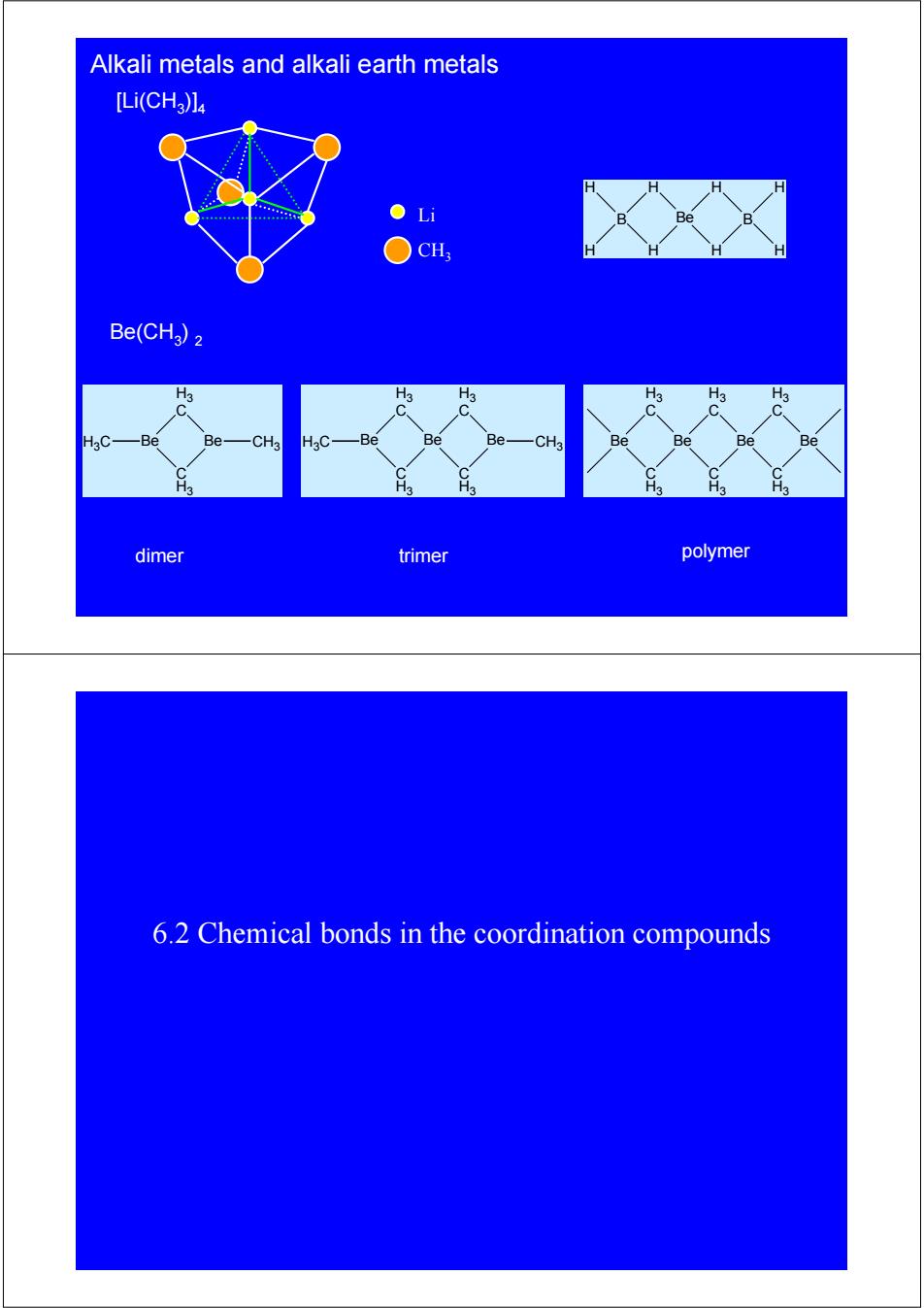
Alkali metals and alkali earth metals [Li(CHa)l : ●Li Be ○CH Be(CHa)2 H3 H3 H3 C -Be Be- -CH3 H3C -Be Be Be- CH3 Be Be Be Be H3 H3 H3 dimer trimer polymer 6.2 Chemical bonds in the coordination compounds
Alkali metals and alkali earth metals Li CH3 polymer [Li(CH3)]4 Be(CH3) 2 dimer trimer Be H3 C C H3 Be C H3 H3 C Be H3 C C H3 Be Be H3 C H3C C H3 Be C H3 H3 C Be Be CH3 H3 C H3C C H3 Be CH3 B H H H H Be H H B H H 6.2 Chemical bonds in the coordination compounds
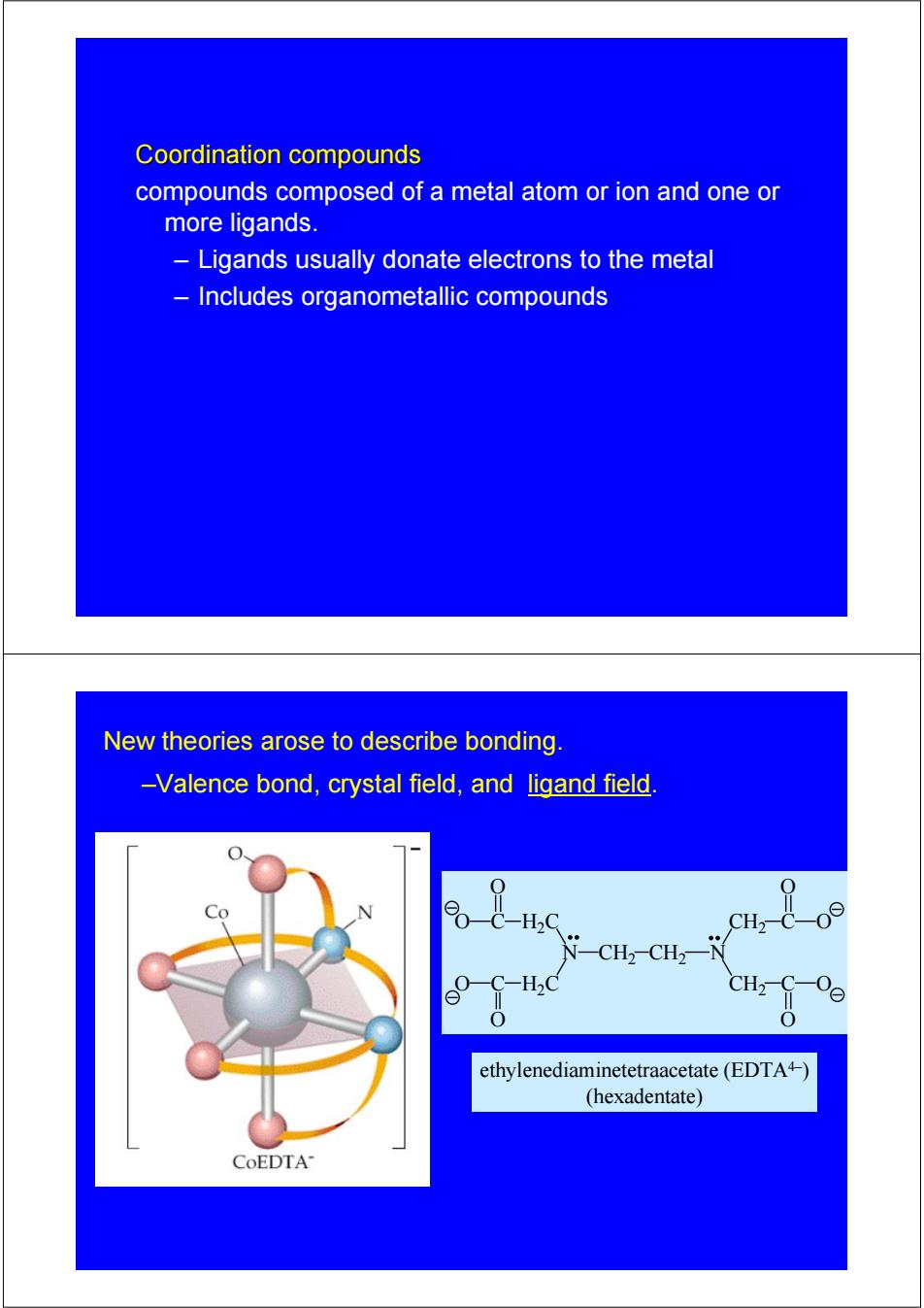
Coordination compounds compounds composed of a metal atom or ion and one or more ligands. Ligands usually donate electrons to the metal Includes organometallic compounds New theories arose to describe bonding. -Valence bond,crystal field,and ligand field Co H.c ethylenediaminetetraacetate(EDTA4-) (hexadentate) CoEDTA
Coordination compounds Coordination compounds compounds composed of a metal atom or ion and one or more ligands. – Ligands usually donate electrons to the metal – Includes organometallic compounds New theories arose to describe bonding. –Valence bond, crystal field, and ligand field. N CH2 CH2 N CH2 C O O CH2 C O O C H2C O O C H2C O O ethylenediaminetetraacetate (EDTA4–) (hexadentate)
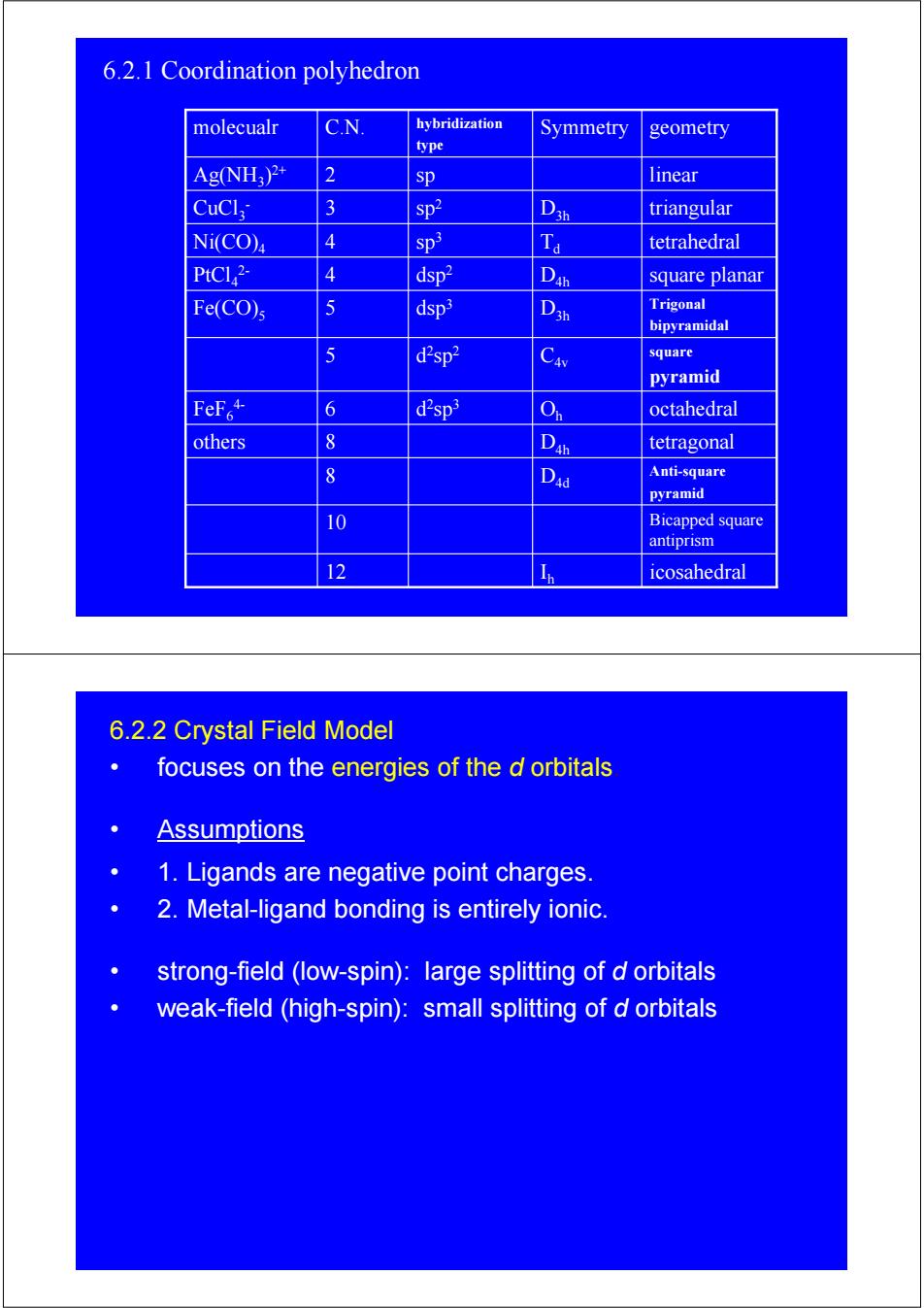
6.2.1 Coordination polyhedron molecualr C.N. hybridization Symmetry geometry type Ag(NH:)2+ 2 sp linear CuCl 3 sp2 triangular Ni(CO)4 4 Sp3 tetrahedral PtCl2- 4 dsp2 D square planar Fe(CO)s 5 dsp3 Trigonal bipyramidal 5 d2sp2 Cav square pyramid FeF+ 6 d2sp3 octahedral others 8 D tetragonal 8 Dad Anti-square pyramid 10 Bicapped square antiprism 12 Icosahedral 6.2.2 Crystal Field Model focuses on the energies of the d orbitals Assumptions 1.Ligands are negative point charges. 2.Metal-ligand bonding is entirely ionic. strong-field (low-spin):large splitting of d orbitals weak-field (high-spin):small splitting of d orbitals
I icosahedral 12 h Bicapped square antiprism 10 Anti-square pyramid 8 D4d D tetragonal others 8 4h O octahedral d h 2sp3 FeF6 6 4- square pyramid d C4v 2sp2 5 Trigonal bipyramidal dsp D3h 3 Fe(CO)5 5 D square planar dsp 4h 2 PtCl4 4 2- T tetrahedral d sp3 Ni(CO)4 4 D triangular 3h sp2 CuCl3 3 - Ag(NH 2 sp linear 3)2+ Symmetry geometry hybridization type molecualr C.N. 6.2.1 Coordination polyhedron 6.2.2 Crystal Field Model • focuses on the energies of the d orbitals. • Assumptions • 1. Ligands are negative point charges. • 2. Metal-ligand bonding is entirely ionic. • strong-field (low-spin): large splitting of d orbitals • weak-field (high-spin): small splitting of d orbitals